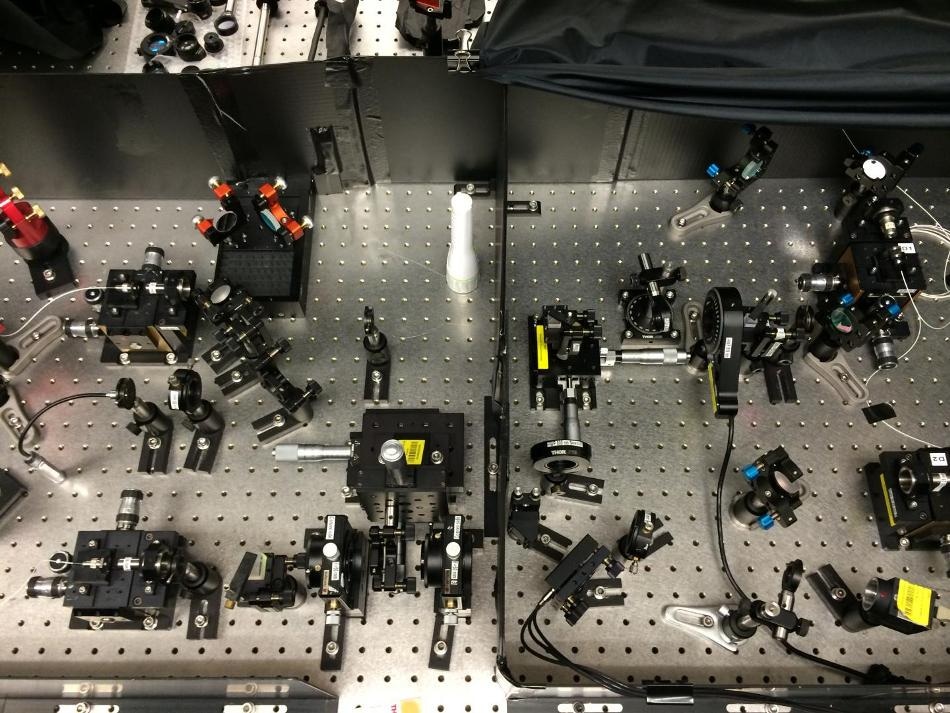Nov 22 2017
A time-resolved spectroscopy method that allows studying fast processes in samples has been developed by a global research group in association with scientists from the MSU.
The new method functions by analyzing quantized light transmitted through a sample, without the need for complex detection systems and femtosecond lasers. This design is much cheaper than the one currently in use and allows one to study a sample without damaging it. The research has been featured in the Scientific Reports journal.
 Interferometer developed at Moscow State University. CREDIT Elizaveta Melik-Gaikazyan
Interferometer developed at Moscow State University. CREDIT Elizaveta Melik-Gaikazyan
One of the most common ways of exploring processes and interactions that occur in a substance is based on measuring the time taken by a sample for responding to external electromagnetic fields affecting it. According to this temporal response, one can judge which connections exist between the components of the substance. As these times are frequently measured by femtoseconds (10-15 sec), in such experiments it is normal to make use of femtosecond lasers that can produce ultrashort pulses.
The issue here is that, firstly, femtosecond lasers contain high power, and can thus damage the object under investigation, and secondly, these lasers are not cheap. The researchers solved this problem by developing a scheme that enables studying samples with single photons and employing ordinary lasers for producing them.
The setup is made up of the simplest interferometer that makes it possible to precisely measure the interference of light. A nonlinear crystal is placed on the laser path in the assembled circuit. In it, pairs of entangled photons are developed and fly off at a particular angle. The phenomenon of quantum entanglement develops in two or more particles, which can be separated by randomly long distances, but carry on to "feel" each other, meaning that an attempt to measure the parameters of one particle results in an instant determination of the state of the other.
"Thanks to this design, we can measure femtosecond times without a femtosecond laser, using single photons," explained the co-author of the article, a graduate student at the Faculty of Physics of Lomonosov Moscow State University, Elizaveta Melik-Gaykazyan.
The test sample is placed inside one arm of the interferometer. One photon of the pair passes via it and hit the beam splitter, where it meets counterpart that has passed via the second arm. Following this, the photons fall on one of two detectors, which react to single photons. This allows it to construct a coincidence circuit: if both photons go to varied detectors, it is one; if they go to the same detector, it is zero coincidence. At the moment when the delay between the two arms becomes totally identical, the effect of quantum interference happens - coincidence completely disappears, since photons never fall on both detectors at the same time.
If the sample is placed into the photons' path, the pattern of the quantum interference begins to change. In this case, the pairs of entangled photons that reach the splitter become less "identical" than in a situation where there is no sample. The photon reception statistics on the two detectors changes due to this, and based on the change in this statistics it is possible to judge the nature of the interactions in the substance under study, for instance to guess the transition time from the excited state to the unexcited state.
For her research, Melik-Gaikazyan received support in the framework of the SIPGA scholarship program, established by the Agency for Science, Technology and Research (Republic of Singapore). She has developed an experimental setup, measured the interference pattern without and with the test sample, obtained experimental data and also analyzed it.
The researchers have both tested and verified the developed method on two samples: a matrix of dielectric nanoparticles and a Nd:YAG crystal (an aluminum-yttrium garnet with neodymium).
The new method of analyzing unknown substances can be used in chemistry, biology, and materials science, in addition, it can be useful when creating a quantum computer, and when trying to understand how to use quantum light in information technology.
Elizaveta Melik-Gaykazyan, a graduate student at the Faculty of Physics of Lomonosov Moscow State University.